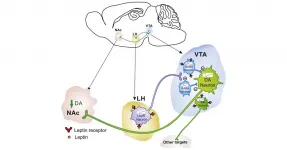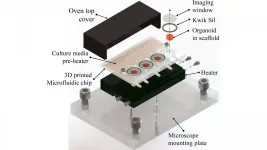AGA recommends intragastric balloons as an additional weight loss strategy for obese patients
The American Gastroenterological Association (AGA) issues formal recommendations on the use of intragastric balloons for obesity
2021-04-06
(Press-News.org) Bethesda, MD (April 6, 2021) -- Obesity is a global pandemic, affecting about 40% of adults in the United States. There is an enormous unmet need for an effective weight-loss solution. After a detailed review of available literature, the American Gastroenterological Association (AGA) has released new clinical guidelines recommending the use of intragastric balloons (IGB) for patients with obesity who have not been able to lose weight with traditional weight-loss strategies. This treatment is most successful with accompanying therapy, such as lifestyle modifications and pharmacological agents, and can be used in a sequential manner or along with bariatric surgery. These guidelines are published in Gastroenterology, AGA's official journal.
"Endoscopic bariatric therapies have evolved as an attractive tool for weight loss, however, less than 5% of patients with obesity seeking a weight loss therapy are aware of endoscopic weight loss options," said lead author Thiruvengadam Muniraj, MD, MRCP, from Yale University School of Medicine, New Haven, Connecticut. "Our hope is that this new guideline can lead to shared decision making between patients and providers to determine if intragastric balloons are the best weight loss option for that individual patient."
With the exception of acknowledgement that fluid-filled balloons may be associated with higher efficacy but lower tolerability than air-filled balloons, the guideline makes no recommendations on specific devices.
Key guideline recommendations:
1. Patients with obesity seeking a weight loss intervention should consider using intragastric balloon therapy to augment the effect of moderate to high intensity lifestyle modifications.
2. To minimize gastrointestinal bleeding risk, treat patients undergoing IGB therapy with proton pump inhibitors (PPIs).
3. To avoid nausea, sedate patients for the IGB placement with anesthetics associated with low incidence of nausea, and continue anti-nausea medication for two weeks.
4. While screening for nutritional deficiencies isn't needed, providing 1-2 multivitamins after IGB placement is suggested.
5. To keep weight off after IGB removal, AGA recommends dietary interventions, pharmacotherapy, repeat IGB or bariatric surgery. The choice of this maintenance strategy should be determined based on a shared decision-making approach.
"Shared decision making is a critical component of obesity therapy - for everything from selecting the right IGB device to what concomitant lifestyle modifications, pharmacotherapy or sequential procedures a patient should pursue. This shared decision making should consider the patient's values and preferences, balance benefits and harms within the patient's clinical and behavioral context, and consider cost and availability," added Dr. Muniraj.
INFORMATION:
Read the AGA Clinical Practice Guidelines on Intragastric Balloons in Management of Obesity to review the complete recommendations.
Resources:
Guidelines
Technical review
Spotlight
Clinical Decision Support Tool
Patient Guide
Media contact: Courtney Reed, media@gastro.org, 301-272-0025
About the AGA Institute
The American Gastroenterological Association is the trusted voice of the GI community. Founded in 1897, the AGA has grown to more than 16,000 members from around the globe who are involved in all aspects of the science, practice and advancement of gastroenterology. The AGA Institute administers the practice, research and educational programs of the organization. http://www.gastro.org.
AGA is now on Instagraminstagram.com/amergastroassn/.
Like AGA on Facebookfacebook.com/AmerGastroAssn.
Follow us on Twitter @AmerGastroAssn.
Check out our videos on YouTube.
Join AGA on LinkedIn.
ELSE PRESS RELEASES FROM THIS DATE:
2021-04-06
Researchers have uncovered pathways involved in the body's response to glucocorticoid treatments and identified a novel biomarker that could be used to monitor how these drugs work in patients, according to a clinical study published today in eLife.
A more reliable indicator of an individual's response to glucocorticoid drugs could be used to develop a clinically applicable test that could help tailor treatments and potentially minimise side-effects.
Glucocorticoids, such as cortisol, are a type of hormone with key roles in the body's response to stress. Glucocorticoid ...
2021-04-06
Researchers from Skoltech and their collaborators have designed, synthesized and evaluated new compounds that can serve as catholytes and anolytes for organic redox flow batteries, bringing this promising technology closer to large-scale implementation. The two papers were published in the END ...
2021-04-06
A new U.S. Geological Survey study provides an updated, statewide estimate of high levels of naturally occurring arsenic and uranium in private well water across Connecticut. This research builds on a USGS report published in 2017, with the new study including additional groundwater samples and focusing on previously underrepresented areas.
The research, undertaken in cooperation with the Connecticut Department of Public Health, projects that approximately 3.9% of private wells across Connecticut contain water with arsenic at concentrations higher than the U.S. Environmental Protection Agency's maximum contaminant level for ...
2021-04-06
Sea urchins receive a lot of attention in California. Red urchins support a thriving fishery, while their purple cousins are often blamed for mowing down kelp forests to create urchin barrens. Yet for all the notice we pay them, we know surprisingly little about the microbiomes that support these spiny species.
Researchers at UC Santa Barbara led by geneticist Paige Miller sought to uncover the diversity within the guts of these important kelp forest inhabitants. Their results reveal significant differences between the microbiota of the two species, as well as between individuals living ...
2021-04-06
Philadelphia, April 6, 2021 - Since the discovery of leptin in the 1990s, researchers have wondered, how does leptin, a hormone made by body fat, suppress appetite? Despite tremendous gains in the intervening three decades, many questions still remain. Now, a new study in mice describes novel neurocircuitry between midbrain structures that control feeding behaviors that are under modulatory control by leptin. The study appears in Biological Psychiatry, published by Elsevier.
John Krystal, MD, Editor of Biological Psychiatry, said of the findings, "Omrani and colleagues shed light on how, in non-obese animals, leptin puts the brakes on overeating."
Leptin acts as a critical link between the body and the brain, providing information about metabolic ...
2021-04-06
In addition to smoothing out wrinkles, researchers have found that the drug Botox can reveal the inner workings of the brain. A new study used it to show that feedback from individual nerve cells controls the release of dopamine, a chemical messenger involved in motivation, memory, and movement.
Such "self-regulation," the researchers say, stands in contrast to the widely held view that the release of dopamine -- known as the "feel good" hormone -- by any cell relied on messages from nearby cells to recognize that it is releasing too much of the hormone.
Led by researchers at NYU Grossman School of Medicine, ...
2021-04-06
WASHINGTON, April 6, 2021 -- Scientists from MIT and the Indian Institute of Technology Madras have grown small amounts of self-organizing brain tissue, known as organoids, in a tiny 3D-printed system that allows observation while they grow and develop. The work is reported in Biomicrofluidics, by AIP Publishing.
Current technology for real-time observation of growing organoids involves the use of commercial culture dishes with many wells in a glass-bottomed plate placed under a microscope. The plates are costly and only compatible with specific microscopes. They do not allow for the flow or replenishment of a nutrient medium to the growing tissue.
Recent advances have used a technique known as microfluidics, where a nutrient ...
2021-04-06
WASHINGTON, April 6, 2021 -- Cryocoolers are ultracold refrigeration units used in surgery and drug development, semiconductor fabrication, and spacecraft. They can be tubes, pumps, tabletop sizes, or larger refrigerator systems.
The regenerative heat exchanger, or regenerator, is a core component of cryocoolers. At temperatures below 10 kelvins (-441.67 degrees Fahrenheit), performance drops precipitously, with maximum regenerator loss of more than 50%.
In their paper, published in Applied Physics Letters, by AIP Publishing, researchers at the University of Chinese Academy of Sciences used ...
2021-04-06
WASHINGTON, April 6, 2021 -- Dragonfly wings, lotus leaves, cicada wings -- thanks to millennia of evolution, nature has optimized the ways these surfaces and others behave to offer antibacterial functionality.
An international, interdisciplinary team of researchers is trying to find the best way to translate these features to create nature-inspired bactericidal surfaces for use in medical implants. They discuss the surface structures and chemical compositions for an ideal implant material in the journal Applied Physics Reviews, from AIP Publishing.
"Objects in ...
2021-04-06
What The Study Did: Researchers compared the effectiveness of case-based (including contact tracing and quarantine) and population-based (including social distancing and facial masking) interventions for COVID-19 containment in Taiwan, one of the few countries with initial success in COVID-19 control without strict lockdown or school closure.
Authors: Hsien-Ho Lin, M.D., Sc.D., of National Taiwan University in Taipei, Taiwan, is the corresponding author.
To access the embargoed study: Visit our For The Media website at this link https://media.jamanetwork.com/
(doi:10.1001/jamainternmed.2021.1644)
Editor's Note: The article includes conflicts of interest and funding/support disclosures. Please see the article for additional information, including ...
LAST 30 PRESS RELEASES:
[Press-News.org] AGA recommends intragastric balloons as an additional weight loss strategy for obese patients
The American Gastroenterological Association (AGA) issues formal recommendations on the use of intragastric balloons for obesity



